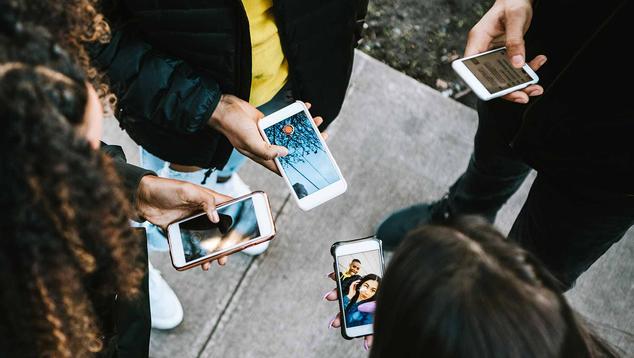Story Highlights
- Less than half of social media account holders post content at least occasionally
- Facebook, Instagram users most likely to post content
- Facebook and YouTube are used more frequently than other platforms
WASHINGTON, D.C. -- U.S. adults commonly engage with popular social media platforms but are more inclined to browse content on those websites and apps than to post their own content to them. The vast majority of those who say they use these platforms have accounts with them, but less than half who have accounts -- and even smaller proportions of all U.S. adults -- post their own content.
The survey finds that U.S. adults are more likely to use Facebook and YouTube than other popular platforms, with 76% saying they have used Facebook and 89% YouTube, and majorities saying they use each at least weekly. Instagram is the third-most used of the six platforms measured in the survey, with LinkedIn, Twitter and TikTok trailing.
About half of Facebook account holders -- 49%, equal to 35% of all U.S. adults -- say they post content to that platform at least occasionally. Instagram account holders are the next-most likely to post content, with 42% of them, equivalent to 20% of Americans, doing so.
Although YouTube is one of the most widely used social media platforms, relatively few YouTube members (11%) post their own content either frequently or occasionally. Far fewer Americans are on Twitter, but a full third of Twitter account holders post content on it. As a result, when looked at from the perspective of the country as a whole, more U.S. adults post content on Twitter (11%) than on YouTube (7%).
The results are based on Gallup’s Dec. 5-19 survey with more than 1,800 members of Gallup’s probability-based U.S. panel who are aged 18 and older. The sample is designed to be representative of the U.S. adult population. The survey sample does not include people without internet access, a relatively small proportion of the U.S. adult population.
Younger Adults More Active on Social Media, Except for Facebook
Whether it is defined as frequency of social media site usage, registering for an account or contributing to site content, younger adults are far more active than older adults across almost all social media platforms. The one exception is Facebook, for which there are no meaningful age differences in any of these activities.
The greatest age differences in social media usage are for Instagram, with a 35-percentage-point gap between the oldest and youngest generations’ regular usage. Fifty-six percent of 18- to 34-year-olds say they use Instagram daily or weekly, compared with 21% of Americans aged 55 and older. Additionally, young adults (66%) are more than twice as likely as the oldest adults (27%) to have an Instagram account and are five times more likely to post content at least occasionally on Instagram, 33% to 6%.
But even among young adults, only half of those with Instagram accounts post content to the platform, given that 66% of young adults have Instagram accounts and 33% post content there.
For other social media platforms, far less than half of young adult account holders post content.
Age differences are generally larger than those seen in other key demographic subgroups. However, there are pronounced educational and income differences with respect to use of LinkedIn, the business and career-oriented social media platform.
- Fifty-eight percent of college graduates and 51% of upper-income respondents (those whose annual household income is $90,000 or greater) have LinkedIn accounts, compared with 26% of college nongraduates and 22% of lower-income respondents (those whose annual household income is less than $48,000).
- Also, 25% of all college graduates and 21% of upper-income Americans report using LinkedIn at least weekly, compared with 8% of college nongraduates and 7% of lower-income Americans.
Where political differences exist in social media usage, they tend to be modest, with Democrats more likely than Republicans to hold social media accounts and to report being more active on social media. The political differences that do exist likely stem from age differences in both social media usage and political preferences, as young adults tend to skew more Democratic, politically. For example, 37% of Democrats and 29% of Republicans have a Twitter account, and 14% of Democrats versus 8% of Republicans say they frequently or occasionally post content to Twitter.
Few Americans Delete Accounts
Elon Musk’s purchase of Twitter last year resulted in increased media coverage of the company. He made sweeping changes there, including laying off about half of its staff in his first few days as owner and reinstating accounts for users who had been banned for violating Twitter user policies, including former President Donald Trump.
In addition to measuring current account usage, the survey asked U.S. adults whether they had previously held an account with each of the six social media platforms. Generally speaking, relatively few U.S. adults appear to delete accounts once they have established them, and that practice appears to be no more common for Twitter than for other platforms, even after the recent Twitter controversies. Overall, 3% of U.S. adults say they previously had a Twitter account but no longer do. That compares with 2% who report having deleted Facebook, Instagram, TikTok or YouTube accounts, and 1% who have deleted a LinkedIn account.
Also, recent events do not appear to be affecting Twitter usage disproportionately more than other social media platforms. A separate question in the survey asked people how their usage of the various social media platforms has changed in the past month. For Twitter, 9% of U.S. adults say they are using it more often, 36% say they are using it less often and 51% about the same as before. Respondents answered the question similarly for other social media platforms.
Bottom Line
Americans are active on social media platforms, in terms of using them and having accounts, but much less so in contributing content for other people to consume. From that perspective, Americans seem to use social media more as information sources to find out what is happening with others and to hear what others think than to share their own experiences and opinions with other people.
Younger Americans, most of whom grew up with social media, are much more inclined to use them, including to post their own material, but sharing original content still appears to be the exception rather than the rule for young adults.
To stay up to date with the latest Gallup News insights and updates, follow us on Twitter.
Learn more about how the Gallup Panel works.



